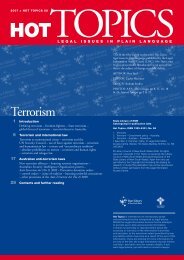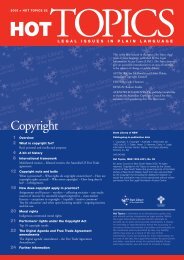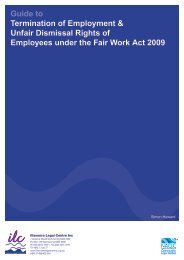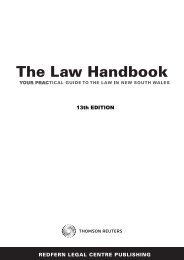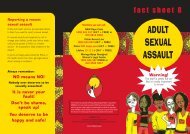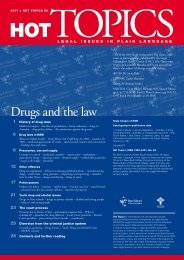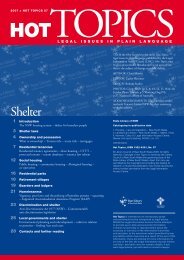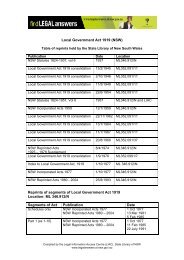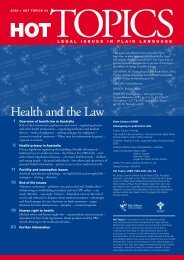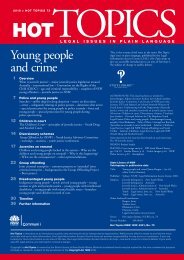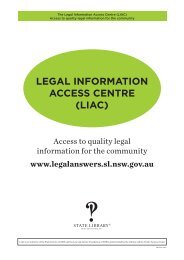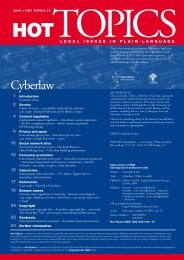Aboriginal people and the law - Legal Information Access Centre
Aboriginal people and the law - Legal Information Access Centre
Aboriginal people and the law - Legal Information Access Centre
You also want an ePaper? Increase the reach of your titles
YUMPU automatically turns print PDFs into web optimized ePapers that Google loves.
56 The Law H<strong>and</strong>book• <strong>the</strong> NSW <strong>Aboriginal</strong> L<strong>and</strong> Council (covering<strong>the</strong> state)• 13 regional l<strong>and</strong> councils• 120 local <strong>Aboriginal</strong> l<strong>and</strong> councils.However, amendments to <strong>the</strong> Act, passed on4 December 2006, abolished regional l<strong>and</strong>councils.[2.340] Obtaining l<strong>and</strong> under<strong>the</strong> Act<strong>Aboriginal</strong> <strong>people</strong> can obtain l<strong>and</strong> or associatedrights under <strong>the</strong> Act through:• l<strong>and</strong> claims (s 36)• purchase of l<strong>and</strong>s (ss 12(b), 23(c), 38)• acquisition by <strong>the</strong> Minister for <strong>Aboriginal</strong>Affairs (s 39)• access to l<strong>and</strong> for hunting <strong>and</strong> fishing(ss 47, 48)• rights to minerals (s 45) <strong>and</strong> royalties(s 46)• community benefits schemes <strong>and</strong> socialhousing schemes provided by local <strong>Aboriginal</strong>l<strong>and</strong> councils (ss 52A <strong>and</strong> 52B).L<strong>and</strong> claimsL<strong>and</strong> claims under <strong>the</strong> Act can be made onlyby local l<strong>and</strong> councils, or by <strong>the</strong> NSW<strong>Aboriginal</strong> L<strong>and</strong> Council on behalf of one ormore local l<strong>and</strong> councils. The claims arelimited to vacant crown l<strong>and</strong> not <strong>law</strong>fullyused or occupied, or required or likely to berequired for an essential public purpose orfor residential purposes.ProcedureClaims are normally prepared by <strong>the</strong> locall<strong>and</strong> council, often with legal advice fromsolicitors or <strong>the</strong> NSW <strong>Aboriginal</strong> L<strong>and</strong>Council. They are lodged with <strong>the</strong> registrarappointed under <strong>the</strong> Act, who certifies that<strong>the</strong> l<strong>and</strong> claimed is within <strong>the</strong> boundary of<strong>the</strong> local l<strong>and</strong> council <strong>and</strong> <strong>the</strong>n sends <strong>the</strong>claim to <strong>the</strong> Minister for Crown L<strong>and</strong>s (<strong>the</strong>Minister for L<strong>and</strong>s) for determination.The minister's responsibilityThe minister gives notice of <strong>the</strong> claim torelevant government agencies, including localgovernment. These agencies may object,but only on <strong>the</strong> ground that <strong>the</strong> l<strong>and</strong> isrequired or likely to be required for anessential public purpose or for residentialpurposes.If <strong>the</strong> minister is satisfied that <strong>the</strong> l<strong>and</strong> isvacant crown l<strong>and</strong> <strong>and</strong> not required for anessential public purpose or residentialpurposes, <strong>the</strong> claim must be granted.Appeal against refusalIf <strong>the</strong> minister refuses <strong>the</strong> claim, <strong>the</strong> local<strong>Aboriginal</strong> l<strong>and</strong> council may take <strong>the</strong> matteron appeal to <strong>the</strong> L<strong>and</strong> <strong>and</strong> EnvironmentCourt. The claim is <strong>the</strong>n heard from <strong>the</strong>beginning by a justice of <strong>the</strong> L<strong>and</strong> <strong>and</strong>Environment Court, usually sitting with acommissioner who is <strong>Aboriginal</strong>.Ei<strong>the</strong>r party may appeal from <strong>the</strong> decisionto <strong>the</strong> NSW Court of Appeal (L<strong>and</strong> <strong>and</strong>Environment Court Act 1979 (NSW), s 57).When a claim is grantedOnce a claim is granted <strong>the</strong> l<strong>and</strong> is transferredas freehold to <strong>the</strong> claimant <strong>Aboriginal</strong>l<strong>and</strong> council.Leaseback as national parkSection 36A of <strong>the</strong> <strong>Aboriginal</strong> L<strong>and</strong> Rights Actallows l<strong>and</strong> to be leased back to <strong>the</strong> NationalParks <strong>and</strong> Wildlife Service as a nationalpark.This is a useful option where <strong>the</strong> l<strong>and</strong>s arerecognised by <strong>the</strong> local l<strong>and</strong> council asrequiring protection for natural or culturalheritage values. Under s 71AE of <strong>the</strong> NationalParks <strong>and</strong> Wildlife Act 1974 (NSW) <strong>the</strong>Minister pays rent for <strong>the</strong> l<strong>and</strong> to <strong>the</strong> Local<strong>Aboriginal</strong> L<strong>and</strong> Council that owns <strong>the</strong>l<strong>and</strong>. The leased l<strong>and</strong> is managed by a boardof management under s 71AN of <strong>the</strong> Act,under which a majority of <strong>the</strong> board must be<strong>Aboriginal</strong> <strong>people</strong>. The board must alsoprepare plans of management for <strong>the</strong> l<strong>and</strong>sunder its control. Boards of managementhave access to funds to perform <strong>the</strong>ir functionsthrough s 71AQ of <strong>the</strong> National Parks<strong>and</strong> Wildlife Act.Purchase of l<strong>and</strong>sThe <strong>Aboriginal</strong> L<strong>and</strong> Rights Act provided for<strong>the</strong> NSW <strong>Aboriginal</strong> L<strong>and</strong> Council to bepaid 7.5% of <strong>the</strong> l<strong>and</strong> tax collected each yearfrom 1983, when <strong>the</strong> Act was proclaimed,until 1998. Half <strong>the</strong> money had to be



